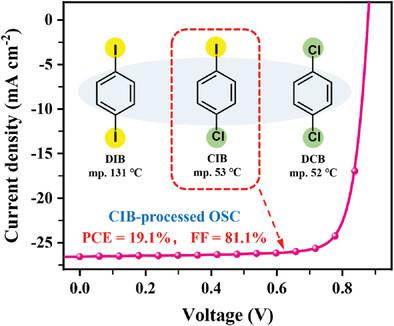当前位置:
X-MOL 学术
›
Adv. Energy Mater.
›
论文详情
Our official English website, www.x-mol.net, welcomes your
feedback! (Note: you will need to create a separate account there.)
In Situ Removable Additive Assisted Organic Solar Cells Achieving Efficiency over 19% and Fill Factor Exceeding 81%
Advanced Energy Materials ( IF 24.4 ) Pub Date : 2023-05-24 , DOI: 10.1002/aenm.202300763 Lingchen Kong 1 , Zesheng Zhang 1 , Ningjiu Zhao 1, 2 , Zekai Cai 3 , Jianqi Zhang 4 , Mei Luo 1 , Xinkang Wang 1 , Mingqing Chen 1 , Wei Zhang 3 , Lianjie Zhang 1 , Zhixiang Wei 4 , Junwu Chen 1
Advanced Energy Materials ( IF 24.4 ) Pub Date : 2023-05-24 , DOI: 10.1002/aenm.202300763 Lingchen Kong 1 , Zesheng Zhang 1 , Ningjiu Zhao 1, 2 , Zekai Cai 3 , Jianqi Zhang 4 , Mei Luo 1 , Xinkang Wang 1 , Mingqing Chen 1 , Wei Zhang 3 , Lianjie Zhang 1 , Zhixiang Wei 4 , Junwu Chen 1
Affiliation

|
Additive engineering can precisely regulate the bulk-heterojunction active layer morphology with ideal domain size and purity, playing a critical role in development of organic solar cells (OSCs). Herein, two solid additives, 1,4-dichlorobenzene (DCB) and 1-chloro-4-iodobenzene (CIB), with low melting point (mp.) of ≈52 °C, are investigated comprehensively with comparison to 1,4-diiodobenzene (DIB, mp. 131 °C). After spin-coating, DIB residue is found in the as-cast PM6:BTP-eC9 based blend film, whereas the DCB and CIB are completely removed during the spin-coating, showing in situ removable properties that enable convenient processing. In OSCs, the DCB- and CIB-processed active layers afford power-conversion efficiencies (PCEs) of 18.2% and 18.4%, respectively, all higher than that of 17.8% for DIB. Among the three solid additives, the CIB is most effective in enhancements of absorption coefficients of the donor and acceptor, affording fast and more balanced carrier transports, and suppressing recombination. Of particular note, the CIB can provide some universality as an in situ removable solid additive, based on its elevations of PCEs for several binary and PM6:D18-Cl:L8-BO ternary active layers. Impressively, a prominent PCE of 19.1% with a remarkable fill factor of 81.1% is achieved for the CIB-processed ternary active layer. This work demonstrates the potential of in situ removable solid additive engineering in high-efficiency OSCs.
中文翻译:

原位可去除添加剂辅助有机太阳能电池效率超过 19%,填充因子超过 81%
增材工程可以精确调节体异质结活性层的形貌,使其具有理想的域尺寸和纯度,在有机太阳能电池(OSC)的开发中发挥着关键作用。本文对两种固体添加剂 1,4-二氯苯 (DCB) 和 1-氯-4-碘苯 (CIB) 进行了全面研究,它们的熔点 (mp.) 约为 52 °C,与 1,4-二氯苯进行了比较。二碘苯(DIB,熔点 131 °C)。旋涂后,在铸态 PM6:BTP-eC9 基共混膜中发现 DIB 残留物,而 DCB 和 CIB 在旋涂过程中被完全去除,表现出原位可去除的特性,可方便加工。在 OSC 中,DCB 和 CIB 处理的有源层的功率转换效率 (PCE) 分别为 18.2% 和 18.4%,均高于 DIB 的 17.8%。三种固体添加剂中,CIB 在增强供体和受体的吸收系数、提供快速且更平衡的载流子传输以及抑制复合方面最有效。特别值得注意的是,CIB 作为一种原位可去除固体添加剂,可以提供一定的通用性,因为它提高了几个二元和 PM6:D18-Cl:L8-BO 三元活性层的 PCE。令人印象深刻的是,经过 CIB 处理的三元有源层实现了 19.1% 的显着 PCE 和 81.1% 的填充因子。这项工作展示了原位可移动固体添加剂工程在高效 OSC 中的潜力。CIB 作为一种原位可去除固体添加剂,可以提供一定的通用性,因为它提高了多个二元和 PM6:D18-Cl:L8-BO 三元活性层的 PCE。令人印象深刻的是,经过 CIB 处理的三元有源层实现了 19.1% 的显着 PCE 和 81.1% 的填充因子。这项工作展示了原位可移动固体添加剂工程在高效 OSC 中的潜力。CIB 作为一种原位可去除固体添加剂,可以提供一定的通用性,因为它提高了多个二元和 PM6:D18-Cl:L8-BO 三元活性层的 PCE。令人印象深刻的是,经过 CIB 处理的三元有源层实现了 19.1% 的显着 PCE 和 81.1% 的填充因子。这项工作展示了原位可移动固体添加剂工程在高效 OSC 中的潜力。
更新日期:2023-05-24
中文翻译:

原位可去除添加剂辅助有机太阳能电池效率超过 19%,填充因子超过 81%
增材工程可以精确调节体异质结活性层的形貌,使其具有理想的域尺寸和纯度,在有机太阳能电池(OSC)的开发中发挥着关键作用。本文对两种固体添加剂 1,4-二氯苯 (DCB) 和 1-氯-4-碘苯 (CIB) 进行了全面研究,它们的熔点 (mp.) 约为 52 °C,与 1,4-二氯苯进行了比较。二碘苯(DIB,熔点 131 °C)。旋涂后,在铸态 PM6:BTP-eC9 基共混膜中发现 DIB 残留物,而 DCB 和 CIB 在旋涂过程中被完全去除,表现出原位可去除的特性,可方便加工。在 OSC 中,DCB 和 CIB 处理的有源层的功率转换效率 (PCE) 分别为 18.2% 和 18.4%,均高于 DIB 的 17.8%。三种固体添加剂中,CIB 在增强供体和受体的吸收系数、提供快速且更平衡的载流子传输以及抑制复合方面最有效。特别值得注意的是,CIB 作为一种原位可去除固体添加剂,可以提供一定的通用性,因为它提高了几个二元和 PM6:D18-Cl:L8-BO 三元活性层的 PCE。令人印象深刻的是,经过 CIB 处理的三元有源层实现了 19.1% 的显着 PCE 和 81.1% 的填充因子。这项工作展示了原位可移动固体添加剂工程在高效 OSC 中的潜力。CIB 作为一种原位可去除固体添加剂,可以提供一定的通用性,因为它提高了多个二元和 PM6:D18-Cl:L8-BO 三元活性层的 PCE。令人印象深刻的是,经过 CIB 处理的三元有源层实现了 19.1% 的显着 PCE 和 81.1% 的填充因子。这项工作展示了原位可移动固体添加剂工程在高效 OSC 中的潜力。CIB 作为一种原位可去除固体添加剂,可以提供一定的通用性,因为它提高了多个二元和 PM6:D18-Cl:L8-BO 三元活性层的 PCE。令人印象深刻的是,经过 CIB 处理的三元有源层实现了 19.1% 的显着 PCE 和 81.1% 的填充因子。这项工作展示了原位可移动固体添加剂工程在高效 OSC 中的潜力。











































 京公网安备 11010802027423号
京公网安备 11010802027423号